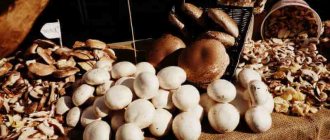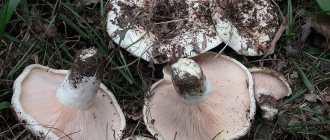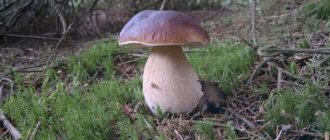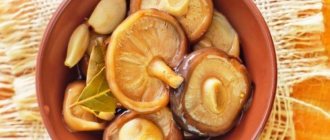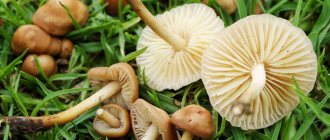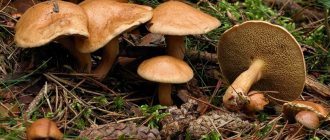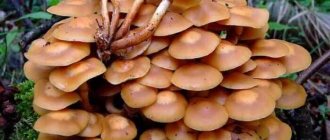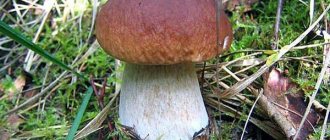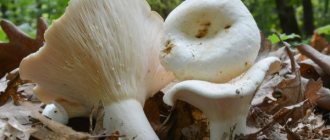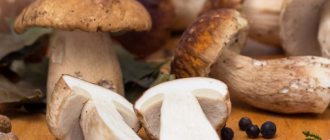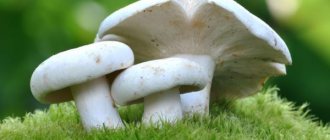General information about the mushroom
Boletus mushrooms are also popularly known as birch mushrooms and blackheads; this type of spongy cap mushroom belongs to the genus Leccinum, or boletus mushroom (Leccinum) of the Boletaceae family.
— Advertising —
The name of this mushroom is “telling,” and indicates that it forms mycorrhiza with the birch trees next to which it grows.
Characteristics of boletus mushroom
hat
The boletus cap is 4-12 cm in diameter, gray, brown or brownish in color, sometimes almost black. Its shape is similar to a swollen pillow.
Pulp
— Advertising —
The pulp is colored uniformly, in light colors, and does not change color when scrapped.
Leg
The leg is 1.5-4 cm in diameter, white or grayish in color, scaly, tapering upward.
Recipes for cooking dishes and preparations
Before cooking, mushrooms should be selected by removing wormy or old specimens. The taste of obabki is well revealed with any method of preparation.
These mushrooms can be used to make a flavorful appetizer. To do this, first make a marinade. 500 g of 5% vinegar is added to 3 liters of water, then 100 g of salt and 120 g of sugar are added there. Spices are added to taste. You can add citric acid.
Mushrooms are boiled in salted water (50 g of salt per 1 liter). During the cooking process, the foam must be removed. When the eggs are at the bottom, they are filtered, placed in jars and poured with boiling marinade. Sterilization is carried out for 50 minutes, after which the containers are rolled up.
To prepare boletus mushrooms in tomato sauce, take 600 g of mushrooms (per 1 kg of finished product). They need to be cut and fried in 120 g of vegetable oil. When the mushrooms become soft, add 200 g of tomato paste diluted in 200 g of water. Then add salt, sugar, and spices if desired. Also add a little 9% vinegar. The whole mass should boil, after which it is simmered for 5-6 minutes over low heat. Sterilization is carried out for 50 minutes and then sealed in jars.
Obabki can be prepared with vegetables such as tomatoes, zucchini and squash. For 1 kg of fruit you will need to take 300 g of tomato paste, vegetable oil, flour and spices.
Fry the mushrooms a little, simmer the tomatoes until soft. Zucchini is cut, rolled in flour and fried. Then all the products are combined, mixed with tomato sauce, spices are added and cooked until cooked. Can be consumed cold or hot.
Not all mushrooms are suitable for storage. Old obabkas have a watery taste, so it is best not to use them. Only young, elastic specimens are taken for drying.
mushrooms can be grown at home if desired
Edibility of boletus
All boletus mushrooms are edible mushrooms; individual species differ slightly in nutritional quality. These mushrooms contain vitamins such as vitamin B1, B2, PP and vitamin C.
In cooking, boletus mushrooms are used fried, boiled and pickled; they are also prepared for future use by drying. When dried, the mushroom turns black.
Boletus mushrooms are used as a filling for pizza, pie, roll, as a base for sauces and in powder form. These mushrooms go well with potatoes, buckwheat, lentils, carrots, cabbage, and peppers.
Boletus mushrooms are prohibited from being eaten by people with gastrointestinal ulcers, those with individual intolerance, and children.
Beneficial features
Boletus dishes are included in some types of diets. It can be boiled, fried, dried and pickled. In any form, obabok benefits the body. Thanks to the action of dietary fiber, an absorption effect is achieved, as a result of which harmful substances are removed from the body. Potassium and phosphorus have a beneficial effect on the functions of the kidneys and adrenal glands and normalize blood sugar levels. The boletus mushroom has a rejuvenating effect.
subject to contraindications for consumption, the mushroom will bring a lot of benefits to human health
Types of boletus mushroom
Common boletus (Leccinum scabrum)
The cap is white to dark gray and black; in a young mushroom it is white underneath, in a mature one it is grayish-brown. The leg is thickened at the bottom, white, covered with scales. The pulp is white and does not change color when scrapped.
It grows in birch groves from the first half of summer until autumn, as well as in the tundra and forest-tundra. Found in Eurasia, North and South America.
An edible mushroom, it is used for food in fried, boiled, dried and pickled forms.
Gray boletus, hornbeam (Leccinum carpini)
The cap is 7-14 cm in diameter, at first hemispherical in shape, with a curved edge at the bottom, later cushion-shaped. The surface is uneven, wrinkled, velvety. The skin is dry, matte, in humid weather it becomes shiny, olive-brown in color. The pulp is white, soft in the cap, fibrous in the stem, when cut it becomes pinkish-violet and gradually almost black. The leg is 5-13 cm long, about 4 cm in diameter, cylindrical in shape, with a club-shaped thickening at the bottom. The color of the leg is olive-gray above, brownish below, and the surface is scaly.
Mycorrhiza forms with hornbeam, hazel, and poplar. Grows in deciduous forests of Eurasia. The season is from June to October.
Edible mushroom, poorly stored.
Stiff boletus (Leccinum duriusculum)
The cap is 6-15 cm in diameter, in young mushrooms it is hemispherical in shape, with age it becomes convex, cushion-shaped, the center is depressed. The skin is slightly pubescent or scaly; in mature mushrooms it is bare, smooth, matte, and becomes slimy in wet weather. The color of the cap is gray-brown to reddish-brown, darkening with age. The flesh is hard, white, yellowish-green at the base of the stalk, and turns pink or red when cut. It has a pleasant taste and a faint mushroom smell. The leg is 5-16 cm in height, 1-3.5 cm in thickness, cylindrical or fusiform, pointed at the base, solid, whitish or creamy above, brownish below, scaly.
Found from late July to mid-November in deciduous and mixed forests, mycorrhiza-forming with aspen and poplars. Rare view.
Edible mushroom with dense pulp. Used for food in fresh and dried form.
Marsh boletus (Leccinum holopus)
The hat is about 16 cm in diameter, convex or cushion-shaped. Light, whitish or pale brown in color, dry surface. The pulp is white, soft, greenish, watery. Does not change color when cut, taste and smell are not pronounced. The leg is long, thin, white or grayish in color.
Mycorrhiza forms with birch and grows near swamps, in damp birch and mixed forests. The fruiting season begins in July and lasts until the end of September
An edible mushroom with loose, highly boiled pulp, young mushrooms are eaten.
Black boletus, black cap (Leccinum melaneum)
The cap is 5-9 cm in diameter, dark brown or black. The leg is scaly.
It grows in pine and birch forests, in damp places, and in swamps. Distributed in Eurasia, from Western Europe to Eastern Siberia. The collection season is from July to September.
Pink boletus (Leccinum oxydabile)
The cap is convex in shape, later becomes cushion-shaped, about 15 cm in diameter. The skin is dry, gray-brown to black, decorated with a light marble pattern. The pulp is white, dense, and turns pink when cut. The leg is long, thin, thickens towards the base, sometimes curved.
Grows in damp birch forests, in separate groups, in Eurasia and North America. Fruits in June-October.
Edible mushroom, used fresh for food, suitable for drying and pickling.
Checkerboard boletus (Leccinum nigrescens)
The cap is hemispherical in shape in young mushrooms, later becomes cushion-shaped, diameter is 5-15 cm. The skin is dry, smooth, sometimes felt-like, cracking, yellow-brown. The pulp is light yellow in color, soft, and when cut first turns red or brown, then turns black. The leg is 5-12 cm high, 1-3 cm thick, cylindrical or club-shaped, thickened downwards, yellowish in color, scaly.
Grows near beeches and oaks in warm regions of Europe, singly or in groups. The collection season lasts from June to September.
Edible mushroom, used fresh, dried, pickled. It turns black when dried.
Ash gray boletus (Leccinum leucophaeum)
The hat is convex or cushion-shaped. The skin is light brown, darkens with age, and the surface is smooth. The pulp is white, turns pink when cut. The leg is long, thin, light with dark scales.
It is found in autumn in birch groves of Eurasia.
Edible mushroom.
Variegated boletus (Leccinum variicolor)
Outwardly it resembles the common boletus. The cap of this species is motley and dirty brown. The pulp is white, turns pink when cut. The leg is white with a light blue tint, scaly.
Edible mushroom.
Poisonous and inedible types of boletus mushroom
Gall mushroom or false boletus (Tylopilus felleus)
The diameter of the cap is 4-10 cm, the shape is hemispherical, later rounded-pillow-shaped or prostrate, the surface is dry, pubescent or velvety, later smooth, from yellow-brown to gray or brown. The pulp is white, turns red when cut. The smell is not pronounced, the taste is bitter. The leg is 3-12.5 cm in height, 1.5-3 cm in thickness, cylindrical or club-shaped, widening downward, fibrous, cream-ocher, yellowish in color, reticulate.
A cosmopolitan mushroom, it grows in coniferous and deciduous forests on all continents, both singly and in groups. Fruiting season is June-October.
Young gall mushrooms are confused with porcini mushrooms and boletus mushrooms. It differs from the latter in the absence of scales on the stalk.
Inedible mushroom.
Growing boletus mushroom at home
Boletus spores are difficult to separate from the pulp. Therefore, a solution is prepared from one part of the pulp and 100 parts of water, which is poured over the open roots of the birch. After this, the roots are additionally moistened.
During the dry season, the soil is regularly sprayed with a spray bottle. Watering is carried out in the afternoon, when the sun's rays do not reach the boletus. Moisturizing is also necessary immediately after the first fruiting bodies appear. The garden bed is watered daily with plain water. The first harvest is harvested a year after sowing.
Benefit
Boletus is a tasty, healthy mushroom. Low calorie content makes it popular for dietary, vegetarian nutrition. In a low-calorie menu, mushrooms replace meat, and it is recommended to prepare dishes from already dried mushrooms that have gotten rid of the chitin substance.
The high content of vitamins and minerals is used for medical purposes. Blackhead has a beneficial effect on the central nervous system, regulates blood sugar levels, helps remove toxic substances from the body, improving the functioning of the liver and kidneys.
